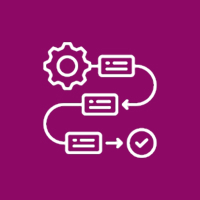Artificial Intelligence is changing the face of software development by allowing organizations to create application that are smarter, more personalized, and have a high degree of automation. For .NET developers, Microsoft has a solid answer: ML.NET, a machine learning framework designed to make AI development feel at home with the .NET ecosystem.
With ML.NET, you can train, build, and deploy a machine learning model in a .NET application using C# or F#, which means you don’t need to learn Python or any other machine learning framework. Whether a recommendation engine, anomaly detection, predictive forecasting, natural language processing, or automation, ML.NET makes it easy to use AI inside your .NET Core application; in short, this is a robust machine learning capability, even if you don’t consider yourself a data scientist.
In this blog post, we will look at what ML.NET has to offer, the usage of the framework and model itself, common use cases, and our best practice on how to embed AI into your .NET Core application.
What is ML.NET?
ML.NET is an open-source, cross-platform machine learning framework specifically created for developers in the .NET vicinity. It provides an extensive range of tools that allow you to:
- Train custom machine learning models for your specific business problems
- Employ pre-trained models for use cases related to vision, text, and natural language
- Embed runnable, AI-enabled features in your existing .NET Core applications
- Ingest data from many sources from SQL, CSV, JSON, APIs, and NoSQL
ML.NET provides support for many machine learning tasks such as:
- Classification (e.g. spam filtering, sentiment analysis)
- Regression (e.g. price prediction, forecasting)
- Clustering (e.g. customer segmentation)
- Recommendation (e.g. recommendations of products)
- Time-series forecasting (e.g. sales or traffic forecasting)
- Anomaly detection (e.g. fraud detection)
ML.NET is a Microsoft-supported framework that continues to evolve with significant community and enterprise support.
Why Choose ML.NET for AI in .NET Core?
1. Fully Embedded in the .NET Ecosystem
ML.NET is fully embedded in the .NET ecosystem so developers can leverage familiar languages, tools, and workflows. There is no need to learn Python or to be dependent on an external ML platform.
2. Low Learning Curve
The API abstracts away complicated machine learning processes, reducing complexity in model building. Developers can build powerful models with a few lines of code.
3. High Performance
ML.NET leverages .NET Core’s performance capabilities. It also supports ONNX Runtime for accelerated inference, enabling deployment of deep learning models trained using ONNX, TensorFlow, or PyTorch.
4. Cross-Platform Support
AI-powered .NET Core applications can run on Windows, Linux, or macOS, making ML.NET suitable for cloud, IoT, and container-based deployments.
5. Automated ML (AutoML)
AutoML automatically suggests the best machine learning algorithms and optimizes hyperparameters, helping even beginners build accurate models with minimal effort.
Prominent AI Applications Using .NET Core with ML.NET
1. Sentiment Analysis
ML.NET can classify text data from customer reviews, messages, or support tickets into positive, negative, or neutral sentiment. Companies can utilize this feature for improved customer experience and to understand customer feedback/evaluations.
2. Product Recommendation
ML.NET allows providing recommendations in a similar fashion that is customary for leading eCommerce websites, as it incorporates aspects of user behavior, previous purchases, or browsing histories.
3. Fraud & Anomaly Detection
ML.NET can help identify anomalies in payments or patterns in system logs. This can be very useful in financial apps, cybersecurity, or monitoring applications in general.
4. Forecasting & Predictive Analytics
Organizations can also employ ML.NET to make predictions about sales, market trends, web site traffic, or supply of inventory, using time-series forecasting models.
5. Image Classification using ONNX Models
Additionally, ML.NET is capable of integrating deep learning models that were trained using TensorFlow or PyTorch. With ONNX Runtime, you can classify images, perform object detection, and more advanced vision tasks directly in .NET Core.
How AI Integration Functions in .NET Core (Simplified Process)
Step 1: Data Preparation
Data collection and cleaning will come from various sources such as CSV files, SQL or NoSQL databases, REST APIs, or cloud storage. Data preprocessing is a core function of model accuracy.
Step 2: Building & Training the Model
Building the training pipeline for the model using ML.NET’s API. The pipeline will include data transformations, feature engineering, and an ML algorithm selection.
Step 3: Model Evaluation
Model performance will be evaluated using metrics based on task type, such as: accuracy, precision, recall, AUC, RMSE, etc.
Step 4: Saving and Loading the Model
After training the model, you will save it as a .zip file. You can then load the model into a .NET Core application without retraining.
Step 5: Model Integration
The prediction engine can then be used in the controller, service, or API, similar to any machine-learning model to predict real-time AI values.
Benefits of Using AI in .NET Core Applications
- Better decision-making: AI insights help companies take action with real data patterns.
- Better Automation: Intelligent workflows reduce the amount of manual effort and automate predictions.
- Better user experiences: Enhanced engagements through personalization and adaptive features.
- Better Operational Efficiency: Predictive analytics allow you to optimize resources and lower costs.
- Better Competitive Advantage: Companies that use AI can create faster and improve development capability.
Best Practices for AI with .NET Core
- Use AutoML to assist with algorithm selection and hyperparameter tuning.
- Ensure that you have high-quality data, as the model’s performance depends heavily on how accurate and relevant that data is.
- When you have new data, you need to retrain your model.
- Use ONNX Runtime to improve the delivery and performance of AI in more advanced problems.
- Monitor your model’s performance in production so that you can flag drift or degradation early.
- Version your models to better help you maintain a clean process for iterating and rolling back.
Conclusion
AI is a vital component of modern applications, and ML.NET gives you powerful machine learning capabilities, embedded in the .NET Core environment. It allows developers to build, train and integrate ML models using languages and tools they already know, eliminating the friction of adopting AI.
From predictive analytics to anomaly detection to personalized user experiences, ML.NET opens up new ways to build intelligent, data-driven .NET applications. As the demand for smart software continues to grow, the integration of AI with .NET Core is not a futuristic option but a critical path to the implementation of innovative, scalable and competitive solutions.
Contact Us Today













 Database Development
Database Development












































